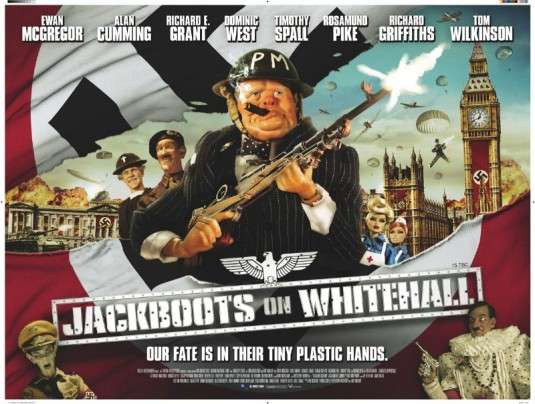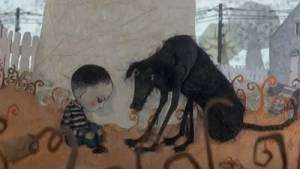-
SFFS Fifth Annual SF International Animation Festival 2010

SFFS Fifth Annual SF International Animation Festival 2010
(For the General Forums links and comments thread go HERE.)
Here Come the Waves: The Hazards of Love Visualized
Peter Sluszka, Julia Pott, Guilherme Marcondes, Santa Maria (USA/England 2009)
Thursday, November 11, 9:00–11:00 pm
La Mar Cebichería Peruana, Pier 1½, Embarcadero Embarcadero Center Cinema
Jackboots on Whitehall
Edward McHenry, Rory McHenry (England 2010)
Thursday, November 11, 9:30 pm
Landmark's Embarcadero Center Cinema
The Best of Annecy
Friday, November 12, 7:00 pm & Sunday, November 14, 12:45 pm
Landmark's Embarcadero Center Cinema
Johnny Ray and Skye: Channel Drift
Friday, November 12, 9:00 pm
Landmark's Embarcadero Center Cinema
Mai Mai Miracle
Saturday, November 13, 12:00 pm
Landmark's Embarcadero Center Cinema
Good Night and Good Luck
Saturday, November 13, 4:30 pm
Landmark's Embarcadero Center Cinema
Semiconductor: Forward Looking Back
Saturday, November 13, 7:20 pm
Landmark's Embarcadero Center Cinema
Play It By Eye
Saturday, November 13, 9:45 pm
Landmark's Embarcadero Center Cinema
Gravity Was Everywhere Back Then
Brent Green (USA 2009)
Sunday, November 14, 2:30 pm
Landmark's Embarcadero Center Cinema
Last edited by Chris Knipp; 08-09-2014 at 03:42 PM.
-
Here comes the waves: The hazards of love visualized (2009)
Opening night, 5th San Francisco International Animation Festival
Here Come the Waves: The Hazards of Love Visualized
Peter Sluszka, Julia Pott, Guilherme Marcondes, Santa Maria (USA/England 2009)

An indie rock album provided with elaborate visuals
This hour-long animation "visualizes" the 2009 "The Hazards of Love" album rock opera or song cycle of the Portland, Oregon indie band The Decembrists, a set of songs inspired by English Sixities folk rock. The title is the name of a 1966 EP album by the English singer Anne Briggs. The Decembrists' album, a Wikipedia article explains, 'tells the tale of a woman named Margaret; her shape-shifting lover, William; his fey forest queen mother; and a cold-blooded, lascivious rake, who recounts with spine-tingling ease how he came "to be living so easy and free" in "The Rake's Song". Lavender Diamond’s Becky Stark and My Brightest Diamond’s Shara Worden deliver the lead vocals for the female characters, while My Morning Jacket’s Jim James, Robyn Hitchcock and The Spinanes’ Rebecca Gates appear in supporting roles. The range of sounds reflects the characters' arcs, from the accordion’s singsong lilt in "Isn’t it a Lovely Night?" to the heavy metal thunder of "The Queen’s Rebuke/The Crossing."'
The film is a floating visual voyage that begins with gently descending seed pods and exploding puff-balls and morphs into imaginary landscapes and animated constellations in deep, rich colors, all very much in the acid trip vein of psychedelic Sixties extravaganzas. But this is more like looking into a kaleidoscope than following a dream narrative in the vein of the Beatles' Yellow Submarine or, to move well into the Seventies, the immortal The Wall of Pink Floyd, who also seem to be a musical influence. It's very pretty but also can seem rather aimless and vapid unless you happen to be a big fan of The Decembrists or folk rock and acutely responsive to the music's changing moods. I didn't personally find that the various songs were very strikingly illustrated in the animated visualizations. As a matter of fact, watching Pink Floyd performing "Time" live at Earls Court on YouTube seemed to me a more exciting visual experience -- as a dramatic accompaniment of rock music -- than this film, and the sound is richer too. There's a limit to how psychedelic folk rock can be. The soaring echo chambers and wailing electric guitars of a psychedelic band like Pink Floyd move the mind more intensely into trippy-ness than the gentle strains. And it's not a bad idea when visualizing music to visualize the performers. Remember how Mickey Mouse meets Maestro Stokowski in Fantasia? Nonetheless Here Come the Waves: The Hazards of Love Visualized does have some spectacular passages, especially at the beginning and the end.
On the other hand, Billboard wrote of this film that "the visuals function as impressionistic landscapes and atmospheres evocative of the unfolding drama like a richly imagined liquid lightshow." I am merely showing my ignorance. Or is it simply that you had to be there, had to be a fan of The Decenbrists' (in fact highly acclaimed) EMI/Capital album delighting in the way this film raises the group by implication to the level of musical visionaries? Obviously, it helps a lot to have an incestuous familiarity with this album before you watch the film. You see what you are ready to see. And I wasn't ready. The album was toured live from Portland through New York’s Radio City Music Hall and on to big summer music gatherings including Bonnaroo, Lollapalooza and Austin City Limits. It grows on you. And as for the film, it certainly deserved to be shown on the big screen as one of the most ambitious animation efforts of the past year.
The collaboration is an impressive one. Peter Sluszkais is a New York-based animator focused on stop-motion and photo-based effects. Julia Pott is a versatile young English animator with a 2009 MA from the Royal College of Art. Guilherme Marcondes is a Brazilian illustrator and animator who has lived and worked in London and (currently) New York. Santa Maria is a directing team comprised of Josh Goodrich and David Hill whose eclectic work bridges styles and includes animation and live action film. Sluszka, Pott, Marcondes, and Santa Maria, respectively, directed four successive segments of the film, each containing four or five musical pieces. Sluszka's ultra-slow motion capture of exploding mushrooms and elegantly disseminating seed pods fades into Julia Pott's line art of wolves and foxes hovering in geometric constellations; then Guilherme Marcondes takes over with his renderings of skeletons caught among leafless branches and verdant human arms that unfurl like ferns. Santa Maria winds up with cosmic computer-generated vistas and cartoons of splintering bones. The various segments were curated by the visual arts collective Flux and the whole was produced by Hornet.
The Opening Night film of the San Francisco International Animation Festival, presented Thursday, November 11 at 7:30 pm at Landmark's Embarcadero Center Cinema in San Francisco.
Here Come the Waves: The Hazards of Love Visualized is available through iTUNES and was released in that form in December 2009.
Excerpt from Marcondes' section on YouTube.
Trailer.
Last edited by Chris Knipp; 08-09-2014 at 03:46 PM.
-
JACKBOOTS ON WHITEHALL (Edward and Rory McHenry 2010)

Poster for the film Jackboots on Whitehall, SF Internat'l Animated Film Festival
Action figures duke it out with satirical Nazis in England
A stop-motion satirical alternative history of WW II borrowing its style from the irreverent humor and crude techniques of Trey Parker and Matt Stone's Team America: World Police, this is an intentionally wacky story in which Nazis take over London, but are opposed by a valiant band of Brits aided by an Indian Punjab Guard regiment and a dashing American resembling Brad Pitt in Inglourious Basterds (clearly a basic point of reference for the whole conception, but there are many other film allusions). Jackboots on Whitehall is an action-figure film that has elicited comments like "My God this film is bad," "What's the point?", "Very poor," "They cannot be serious," as well as "Brilliant!", "A great piece of work!", "If only there were more," etc. Indeed 20-something brothers Edward and Rory McHenry's debut feature is a mixed bag. You'd best take what you like and leave the rest. If you can do that, you'll have a good time. According to Variety, the animation is "a family affair, with father David McHenry credited as production designer, and more brothers, Dominic and Jack McHenry, toiling as puppeteers." David's charming, detailed set design is one of the best aspects of the piece.
The puppets are intricate, their costumes full of detail, but overall they're pretty crude. You can see the rivets, and they have no flexibility. Churchill always has a cigar in his mouth and when anybody talks, the digitally moving mouth can barely be seen. Some early sequences such as the one in which the Nazis approach England in a Hindenburg zeppelin and are fired upon by village folk are dragged out and inexplicable, but the filmmakers had to limit the battles they would show, and they didn't choose to depict their premise action, when the Brits weren't rescued at Dunkirk but got stuck in France so the Germans could invade the Sceptr'd Isle. The Nazis burrow underground and come up in tanks at Trafalgar Square, shooting holes in No. 10 Downing Street. The little band of Brits put up a brave front, but are forced to retreat. The plan is to move up to Hadrian's Wall, by the Scottish border, and make a stand against the Jerries there. The whole film may be a lot less funny than it thinks it is. Some of the writing is repetitive and downright annoying, and the humor a little too obvious. You have to love stop-motion (cum CGI) and relish the premise, and the cast, to give this a thumbs-up, but more will than will not.
There's much to admire and enjoy too. To begin with, the audacious premise never loses its pep. The voice cast is wonderful. Imagine Alan Cumming as Hitler, Ewan McGregor as a Chris, robust, handsome country lad who could not sere in the military because his hands were too big, Timothy Spall as an orotund Winston Churchill who's handy with a machine gun; Richard Griffiths as Hermann Goering, Richard O'Brien as Himmler, Tom Wilkenson as Goebbels and all of these figures beautifully satirized in the puppetry. Rosamund Pike as a comely country maiden, Daisy, whose stuffy, but classic vicar father (Richard E. Grant) doesn't approve one bit of her flirtation with young Chris. And lots more.
The mise-en-scène is very ambitious for a production as evidently low-budget as this, vast interiors, crowd scenes, battles in the streets: and sometimes it's astonishingly beautiful. How this is carried off when sometimes the continuity falters and the writing is lame is one of the film's great mysteries. The humor and the writing are hit-or-miss. Jackboots works best if the overall scheme is not taken too seriously, and you just enjoy the wacky moments. All in all, the rigidity of the puppets is too ittle used for comic effect. Despite good work by the talented actors, particularly in the campy Nazi leaders, the dialogue is far from hilarious. And while the action is well handled in big complicated scenes, the narrative falters on the way from London to Scotland, and the film begins to seem in need of cutting well before its 78 minutes are done. And yet, the McHenry family may have more to give us.
Seen and reviewed as part of the San Francisco International Animated Film Festival in Nov. 2010 (public screening Thursday, November 11, 9:30 pm at Landmark's Embarcadero Center). The film was made in the UK and released there Oct. 8, 2010.
-
PLAY IT BY EYE (11 music videos)

3D CGI androids rock in "Stylo" (Gorillaz) video by Jamie Hewlett, Peter Candlland
Music videos: the search for originality
In judging the SF Animation Festival 2010's 11 new music video choices of course it's hard not to notice the music. But the question is, how original is the video, and how neatly does it contrast with, supplement, or harmonize with the music?
Music videos can be cool just showing the band in action, though that has been jazzed up a million ways by now. Other videos work better as counterpoint, and if they tell an independent story, that's often cool. Gorillaz goes that route. Gorillaz has its ""virtual band" of comic book characters," and the biggest Wikipedia entry of any of the groups. Their song "Stylo" has guest spots by Bobby Womack and Mos Def. The video by Jamie Hewlett and Peter Candlland of England is a Mad Max road chase with the band's creations Murdoc, 2D, and the android Noodle (with a bullet hole in her head) speeding down the road in a bullet-riddled, smoking 1969 Chevrolet Camaro with the word "Stylo" on the front grille. They waste a fat highway cop -- only to be pursued by (quoting from Wikipedia) "Bruce Willis, in a red 1968 Chevrolet El Camino." "The video ends with the Stylo car running off the side of the road and into the ocean, as Bruce looks on contently. The car, submerged underwater, transforms into a shark-like craft and swims out of view." Very satisfying, and the best of the collection.
Here are some that go the more conventional route. Chairlift's "Evident Utensil" video by Ray Tintori of the USA shows the band outdoors singing their song but digitally distorted by new software -- pretty, trippy, but still pretty familiar stuff. Darwin Deez' "Radar Detector" video (by Ace Norton of England) blends in shots of Deez singing his song with a variety of ingenious images of him and stuff: it maintains a lighthearted air, but are the images illustrative or just distracting? Samo-samo, yo? Grizzly Bear's "Two Weeks" video by Patrick Daughters, The Mill LA, USA just shows the band head-on staring at you, singing, but their faces slowly altered. Very arresting, creepy. If you like zombie-nerds, you'll like it, otherwise maybe not: it holds your attention, but also pushes the gag button. CT- PO- Paul Oakenfold's "Starry Eyed Surprise" is a very listenable song, but the USA video producer Honey's approach feels standard issue. The prolific English DJ Mark Ronson and the Business Intl's "Bang Bang Bang" video by Warren Fu of England starts out very high concept with a Japanese guy with a weird wand-like mike speaking French and an Anglo guy speaking Japanese, but the rest is conventional -- digitally ornamented performances shots -- -- except for a tennis match in which heads literally roll. which lingers for a bit in our overstimulated brains. The song features rapper Q-Tip and singer MNDR and was top ten on the UK singles charts.
Gossip's "Pop Goes the World" video by Philip Andelman of the USA is straightforward footage of the band performing on a stark, dramatically lit stage with bands of colored light behind them. This time the filmmaker doesn't get in the way of the performance, just makes the lighting and color stylish. Gossip looks sort of like Diviine in a John Waters movie. Again software comes in to distort the figures and instruments as if they are sort of exploding. But the pulsations of the image follow the beat and never get in the way of the forward momentum of the peppy song. This is not earth-shaking, but it works, and looks stylish.
Now for more counterpoint. Knalpot is "probably the best rock duo to surface in the Netherlands in 2009. Guitar, electronics, drums and an immense dose of energy," said Stream Magazine. You can watch them separately performing their instrumental piece "Casio Halbzeit," two men in identical red watch caps and green T shirts (are they twins, or what?) manning a big drum kit, a guitar, and lots of electronics. "Casio Halbzeit" has a clean, abstract techno sound. The video by Martha Colburn of the USA is hand-drawn animation and collage of political protest that lightheartedly takes issue with the way the world is going and how the will of the people is overridden and how life is generally going -- back to the dinosaurs, it suggests. This is a refreshing combination, better than either sound or image might be by itself.
Das Racist is an offbeat 3-man rap group based in Brooklyn that has some cred now. Their "Who's That? Brown" has an aggressive style. The video is an elaborate, stylized animation fully of symmetry and little rhymically jumpy figures in video-game-like NYC city scenes, while text messages flash below or over the image in a box. Example: "Kool A.D. Jay Z and Justin Bieber's shared stretch Hummer got hit by a meteor on the way to their show." Rap lyrics include: 'I swear I sell like wet sell, sell like sex sell, smell like sex smell/I swear I go like cars go, move like cargo, so retardo/Always move forward, never sleep, like a shark, bro/Always with my people like yar, bro, y'all glo. . . Who's that? Brooown!" Yeah, whatever. Another good example of good counterpoint, video-against-music, though, and anything that makes fun of Sarah Palin is okay, I guess. Edith Sitwell might like the internal rhymes and referential nonsense.
What else? Myles Cooper: "Gonna Find Boyfriends Today" (Skye Thorstense video, USA), is a gay boy smiling and singing with pretty dayglo animation. It's fun, and cute, and so darm pretty. Rage Against the Machine's "Guerilla Radio" sounds a whole lot like the Chili Peppers. The video (by Honey, again) is traditional: clean-looking studio performance film with various illustrative images, easy PC protest, a plug for Mumia, a jab at "pigs" who "try to silence my style" and "vultures who thirst for blood and oil"; "cut the cord" with a picture of an American Express card. We might feel we've seen this all before. But both the song and the video are rife with energy and RATM caused controversy in Brazil: the images of sweatshop workers at sewing machines mean something so this isn't totally routine. But call me a Tarantino freak, but what I'm going to take away from all this is Bruce Willis chasing androids in a 1969 hot rod. That man still epitomizes badass.
Play It By Eye is a presentation of the San Francisco International Animation Festival of 2010, showing Saturday, November 13, 9:45 pm at Landmark's Embarcadero Center Cinema.

Bruce Willils in "Stylo" video
Last edited by Chris Knipp; 08-09-2014 at 03:49 PM.
-
Mai Mai Miracle (Sanbu Katabuchi 2009)
Sunao Katabuchi: MAI MAI MIRACLE (2009)

Shinko, her grandfather, and Kiiko in Mai Mai Miracle
Facing harsh realities with magic and smiles in provincial Fifties Japan
Directed by a former assistant of the great Hayao Miyazaki, (he served as a scriptwriter of Miyazaki's Sherlock Hound and assistant director on his Kiki's Delivery Service), this anime film is Katabuchi's second feature, produced by the premier Madhouse animation house in Japan. Mai Mai Miracle is a charming, touching, and surprisingly complex story about two nine-year-old girls in Kokuga, a farming village (near a factory) in 1950's Japan developed from an autobiographical account by Nabuko Takagi. Though less visually rich than Miyazaki, this film is continually engaging in the way it enters the world of childhood without condescension but with the upbeat-ness in the face of troubles characteristic of anime.
The main character, Shinko (voiced by Mayuko Fukuda) is a free-spirited tomboy much influenced by the tales told her by her grandfather Nagako (Manami Honjou) of Sue, the town as it was called a thousand years ago. Her fantasies based on his lessons and stories lead her to believe she has access to her own special brand of healing magic she connects with her "mai mai," her cowlick in the middle of her forehead. Shinko has many fantasies, which include a lonely princess, Nagiko Kiyohara (Ei Morisako) -- derived from the 11th-century Japanese literary classic the Pillow Book of Sei Shōnagon, whom Shinko believes she's descended from and who is woven in and out of the story. Kiiko (voiced by Nako Mizusawa) is a shy, reserved new girl, daughter of a doctor, who's recently come to Shinko's school from Tokyo and has pale skin and city ways and a sadness because she's yet to get over the death of a mother she barely remembers. The two girls meet in third grade and quickly become great friends. Each helps the other. Shinko learns to deal with reality, and Kiiko learns to develop her imagination.
A lovely early episode depicts how Shinko visits Kiiko's relatively lavish house and wonders at its having two floors, and Kiiko is equally awed by Shinko's more traditional dwelling. Playing with other kids they make a dam and discover a red fish they name after the teacher they adore. The kids hero-worship an admirable policeman, praised by Shinko's grandpa and the father of one of the older boys. Both the policeman and the beloved teacher Hiraku have more dark and complex lives than the kids had realized, leading toward tragedy but also accommodation. There is a suicide, and Shinko feels wrong has been done that she must avenge; this leads her into contact with the seamy side of town and a discovery that things aren't as black and white as she had thought. The shocks and disappointments Shinko experiences cause her to realize that her magic may not be real. As we get to this part of the film it has become surprisingly complex. Neither Mai Mai Miracle nor the screenplay talks down to anybody, even though the playfulness and the ability to laugh are never lost.
What's most appealing and fascinating about this film is the way it oscillates between the real and the imaginary, the upbeat and the sad, while maintaining the deceptively simple surface of childhood. The drawing too is richer than might appear. It's often as elementary as a Fifties school book for young kids (Spot, Dick, Jane), yet the animation flows very smoothly and the style morphs from the bright scenes of the Kokuga wheat fields to the dark gangsterish precincts of the port, and when Shinko describes some of her imaginings to the audience or to Kiiko they initially take the form of simply animated, conceivably childish drawings, while the flashbacks to a thousand years ago have a hazy richness. Reaction shots are convincing, and the voicings are delicate and touching. The musical background is delicate and often unexpected. Katabuchi has made an animation that's traditional without being hackneyed at all. At the end, everything changes, and the two girls are no longer going to be together any more. A lot has happened. The best thing about the story is that it seems both surprising and inevitable. And its simplicity embodies a bipolar message about history and culture. As Ronnie Scheib's Variety review concludes: "Ultimately, 'Mai Mai Miracle' depicts Japan in the '50s, caught between an imperial past of rigid class distinction and its Western-influenced, caste-loose future. Kiiko's ability to channel an imperial princess while mourning her Westernized mother, and Shinko's realization that her classmate's father was not simply seduced by Western influences but carried the seed of his own destruction, sophisticatedly represent two sides of an ambivalent East/West fusion, conveyed with surprising clarity."
Released theatrically in Japan and South Korea in late 2009, Mai Mai Miracle has been shown in various international festivals in 2010. Seen and reviewed as part of the 2010 San Francisco International Animation Festival. Shown to the public Saturday, November 13, 12:00 pm at Landmark's Embarcadero Center Cinema.
Last edited by Chris Knipp; 08-09-2014 at 03:47 PM.
-
The Best of Annecy
THE BEST OF ANNECY

Still from The Lost Thing
The long and the short of Annecy 2010
There were several surprises and differences from last year, and not altogether happy ones, in the selection from the prestigious Annecy, France 50th annual International Animated Film Festival and Market event. There was one rather long short, 20 minutes, one of 16 minutes, and the rest 4-7 minutes. There wasn't as wide a range of styles and approaches as last year's event. There was an emphasi on meticulous and ostentatiously hand-drawn animation and upbeat messages. I'm all if favor of supporting the more human look of the hand-drawn instead of the sometimes overly clean, impersonal creations of computer animation, but last year's Annecy selections showed greater variety and more innovation (as did last year's Play It by Eye music video choices. See my coverage for last year's 4th Annual SFIAF). Different jury, different year. This presentation included all the Annecy 2010 shorts winners except Les Journaux de Lipsett/Lipsett's Diaries, a Canadian film by Theodore Ushev. Note: this was not the "best" of Annecy, only the best shorts. There were various other awarded animations/computer films, such as the innovative and sweet 3 1/2 minute webcam music video from Japan, Sour's Hibi no neiro/Tone of Everyday. 

Still from Angry Man
ANGRY MAN. Some secrets should remain secret (Anita Killi, Norway 2009, 20 min).
That blurb is strange: the film is about not keeping mum about destructive family problems. This is a rather long short, 20 minutes, about child abuse, from Norway, about a little boy who is terrified of his raging dad. The story is horrifying and very sad, though it has a quietly hopeful ending, almost too much so. The drawing is elegant and very expressionistic, which as many have noted of this much-awarded film, conveys the emotions of the boy vividly. (It won both the Special Jury Award and Audience Award here.) Two-dimensional puppets and stop-motion are used. The slogan is "pass it on." The boy is hopeless but the birds in the trees whisper this message to him, and with the help of a rather frightening-looking but beautifully drawn and friendly big black dog the boy writes a note telling what's going on at home with his dad ("he hits") and going right to the top for help: the King! The King then duly appears at his house, robe, crown, and all. The father, who formerly appeared huge, his arms encircling the room and all in it, now shrinks smaller than the little boy and cowers on the floor asking for forgiveness, which leads to his being sent to the palace to cool off. When the boy later goes for a day's visit his father has become kindly, though traces of the terror remain in the traumatized child. "Pass it on." This is a message film designed to appeal to kids and though its way of presenting the problem and its solution is not at all realistic, it might work well with the very young, who knows? There is no doubt that the opening part, which hits its mark right away (arguably a little too soon), is deeply moving and disturbing.
The surprise is that while last year the SF Annency selections were notable for their creative and technical invention, this time many of the films consist (or simulate) hand-drawn storytelling, either just to amuse or to instruct. Many of these films look as if they could have been done in the 1950's. No sense is conveyed this time of how animations can be edgy and adult, or can be wicked or intellectually challenging as well as cute and uplifting.
DON'T GO You can’t see everything, like a cat’s best friends for instance (Turgut Akacik, Turkey 2010, 4 min).
This film uses actual film of a very playful young cat chasing a toy. The toy is animated. Not much too it really, but harmless good fun. Again not quite clear what the point of the blurb line is. The title also seems unclear. Winner of one of several Annecy Special Distinction Awards.

Still from I Forgive You/Je te pardonne
I FORGIVE YOU Two wrestlers have a fight and forgive themselves (Pierre Mousquet, Jérôme Cauwe, Belgium 2009, 5 min).
This film in French depicts super-muscular men who end up kissing each other on the lips in front of a big crowd at the end of a boisterous contest. Does this show that real men can be gentle, or are they gay, or is this just a silly film? Not exactly clear. Perhaps again as in Angry Man, a message for children in intended.
JEAN-FRANÇOIS Jean-François is a swimming champion nostalgic for his childhood spent beside the sea (Tom Haugomat, Bruno Mangyoku, France 2009, 6 min).
This animation, again made up of line drawing and much of it at least done by hand. The drawing is so stylized and full of curves, the figures all so big, round, and bloated, that when he wins and is out in a grand car in a suit (the most visually memorable segment), Jean-François still keeps his swimming cap on, probably so we can recognize who he is from the other similar-looking figures. Too much like Forgive You, this focuses on a strangely de-masculiineized, bloated athlete. Winner of the "Jean-Luc Xiberras" Award for a first film.
LEBENSANDER A girl finds the entire world in a leaf (Angela Steffen, Germany 2009, 6 min).
This film focuses on elaborate psychedelic imagery of shapes within shapes within shapes, curves and colors swallowing each other and returning to an image of a child looking at a leaf. The emphasis is on visual intricacy rather than narrative, of which there is virtually none. Again there is a predominance of curves in the drawing, which is more in the realm of skillful doodles than references to the known world.
THE LOST THING Bring a strange creature home from the beach and see if anybody notices (Andrew Ruhemann, Shaun Tan, Australia 2010, 16 min).
Finally in this too-much-of-a-sameness collection, a real change of pace, and winner of the Crystal for Best Animated Short (Fabulous Mr. Fox, in SFIAF in 2009, won the feature animation prize at Annecy this year). Narrated in a pleasantly everyday Australian voice, The Lost Thing opens up a richer, larger world that goes beyond the sketchbook to the style of children's books, fully populated with quaint mimicry of richly reimagined real-world stuff . A man gathering bottle-caps on the beach for his collection inadvertently comes upon a very large critter that looks like a giant pot with many openings. There is a living beast inside with twirly tentacles. It turns out to be playful and quite friendly. The man takes it around hoping to find where it should go and what can be done with it. While The Lost Thing is more like commercial animation, it is also fresh and original. In both visual and narrative terms, this is a great little film. About a misfit contraption almost nobody loves, this is sort of an understated and concise WALL·E from Down Under.

Still from Love & Theft
LOVE & THEFT "And I’m still carrying the gift you gave, it’s a part of me now, it’s been cherished and saved, it’ll be with me unto the grave, and then unto eternity." (Andreas Hykade, Germany 2009, 7 min). This won the Annecy Special Award for Original Music and the jaunty sounds are attractive and well integrated into the hand-drawn film of constantly morphing centered line images mostly of cartoonish faces and some symbols, which have nothing much to do with the title or blurb but, though repetitious, would have delighted me as a kid. This in concentrated form is a wet dream of Forties-Fifties-Sixties comics, Al Capp meets Walt Disney meets Rudolf Dirks' Katzenjammer Kids meets R. Crumb meets the Hairy Who. (Needless to say, no still can do justice to a film like this, which reminds us that animations consist of, traditionally, thousands of drawings, which flick by second by second, and that's the essence of them.) An elegant and quick-witted little film.
_________________
Overall, instead of including all but one of the winning shorts it could have been better to pare down the very similar films and include contrasting short ones from other categories instead. As representing the biggest most important animation festival in Europe this hour and ten minutes was a bit on the solemn and preachy side. The generalization that animations are uniquely suitable for conveying emotion is a misleading one, since they are traditionally used for comedy, not gloomy lesson-teaching, and have included much mechanical and gleefully sadistic stuff. Just watch any Looney Tunes.
The Best of Annecy (69 min) was seen and reviewed as part of the 2010 San Francisco International Animation Festival. Public screenings were Friday, November 12, 7:00 pm & Sunday, November 14, 12:45 pm at Landmark's Embarcadero Center.
Last edited by Chris Knipp; 08-09-2014 at 03:52 PM.
 Posting Permissions
Posting Permissions
- You may not post new threads
- You may not post replies
- You may not post attachments
- You may not edit your posts
-
Forum Rules





 Reply With Quote
Reply With Quote










Bookmarks